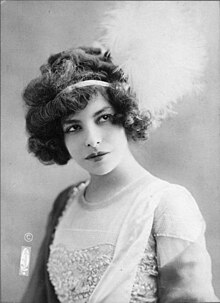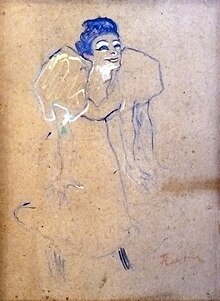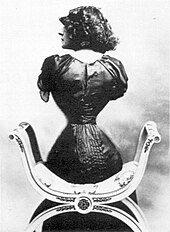| Polaire | |
|---|---|
 Polaire in 1910 Polaire in 1910 | |
| Born | Émilie Marie Bouchaud (1874-05-14)14 May 1874 Agha, Algiers, French Algeria |
| Died | 14 October 1939(1939-10-14) (aged 65) Champigny-sur-Marne, Paris, France |
| Nationality | French |
| Occupation(s) | Singer, actress |
Émilie Marie Bouchaud (14 May 1874 – 14 October 1939), better known by her stage name Polaire, was a French singer and actress, who became internationally known. She performed also in the United States and London, and in films.
She was notable for her wasp waist which, achieved through corsetry, reportedly measured less than 16 inches (41 cm). She was also known for her eccentric stage presence, which generated mixed receptions.
Biography

Early life
Émilie Marie Bouchaud was born in Agha, Algiers, French Algeria on 14 May 1874; according to her memoirs she was one of eleven children. Only four – Émilie, her two brothers Edmond and Marcel, and a sister, Lucile – survived infancy. Their father died of typhoid fever when Émilie was five. Their widowed mother, unable to support the four children, temporarily placed them with their grandmother in Algiers. Bouchaud's brother Marcel died shortly after.
In 1889, after their mother began a relationship with a man named Emmanuel Borgia, she took her children with her when she moved with him to Paris. There her mother found work, and also tried to find domestic employment for her eldest daughter. Eventually however, after her sister Lucile fell sick and died, Émilie was sent back to her grandmother in Algiers.
Borgia, her mother, and Edmond, the only surviving sibling, remained in Paris. Émilie was unhappy and in September 1890 ran away to rejoin her mother in France. Afraid of meeting her mother's partner, Borgia (whom she accuses in her memoirs of having tried to molest her), she first approached her brother Edmond.
He had already gained some fame as a café-concert singer under the name of 'Dufleuve'. With his help Bouchard at about age 17 auditioned successfully for her first job as a café singer.
Career

Polaire's career in the entertainment industry stretched from the early 1890s to the mid-1930s, and encompassed the range from music-hall singer to stage and film actress. Her most successful period professionally was from the mid-1890s to the beginning of the Great War (First World War).
Adopting the stage name Polaire ("Pole Star"), she worked first as a music-hall singer and dancer. One of her earliest hits was performing the French version of "Ta-ra-ra Boom-de-ay". Having quickly made a name for herself – artist Toulouse-Lautrec portrayed her on a magazine cover in 1895 – Polaire briefly visited New York, appearing there as a chanteuse at various venues, but without achieving major success.
On her return to Paris, she extended her range and gained acting roles in serious theatre. Her first major appearance was in 1902, at the Théâtre des Bouffes Parisiens, in the title role of a play based on Colette's Claudine à Paris. A comedic actress, Polaire became one of the major celebrities of her day. Later, as cinema developed, she appeared in several films.
In 1909, Polaire was cast in her first silent-film role in Moines et guerriers (Monks and Warriors). In 1910 she returned to the stage, appearing in London and later in New York. (1910 was the date of her first visit as a celebrity to the U.S.; publicity releases did not mention her earlier appearances in 1895.) In 1912, back in France, she was offered a role in a film by the up-and-coming young director Maurice Tourneur. She appeared in six of his films in 1912 and 1913. After returning to the musical stage, she sailed back to the US for a second tour.
Crossing the Atlantic again, she returned to London to perform at the Coliseum Theatre. In 1915 Polaire made frequent appearances in London, and was involved in wartime fund-raising efforts. She returned to films in 1922 but, in the declining years of her career, had to be content with lesser roles.
Her precise filmography is difficult to determine due to confusion between her and a younger Italian actress with the screen name "Pauline Polaire", who also featured in early films. Her last film appearance was in 1935 in Arènes joyeuses, directed by Karl Anton.

Appearance
Polaire was skilled in using her appearance to attract attention. In her early days as a café singer in the 1890s, she wore very short skirts and also cropped her hair, fashions that did not become common in the rest of society until the 1920s. A brunette, she wore unusually heavy eye makeup, deliberately evocative of the Arab world. At a time when tightlacing among women was in vogue, she was famous for her tiny, corsetted waist, which was reported to have a circumference no greater than 16 inches (41 cm). That accentuated her large bust, which was said to measure 38 inches (97 cm). She stood 165 centimetres (5 ft 5 in) tall. Her striking appearance, both on and off stage, contributed to her celebrity.
For her 1910 supposed "debut" in New York, she provocatively allowed herself to be billed in the advance publicity as "the ugliest woman in the world". When departing on a transatlantic liner, she was apparently accompanied by a "black slave".
Returning to America in 1913, she brought a diamond-collared pet pig, Mimi, and wore a nose-ring. Talk of her figure and her lavish overdressing in fur coats and dazzling jewels preceded her appearances wherever she went. Jean Lorrain said of her:
Polaire! The agitating and agitated Polaire! The tiny slip of a woman that you know, with the waist slender to the point of pain, of screaming out loud, of breaking in two, in a spasmically tight bodice, the prettiest slimness ... And, under the aureole of an extravagant masher's hat, orange and plumed with iris leaves, the great voracious mouth, the immense black eyes, ringed, bruised, discoloured, the incandescence of her pupils, the bewildered nocturnal hair, the phosphorus, the sulphur, the red pepper of that ghoulish, Salome-like face, the agitating and agitated Polaire! What a devilish mimic, what a coffee-mill and what a belly-dancer! Yellow skirt tucked high, gloved in open-work stockings, Polaire skips, flutters, wriggles, arches from the hips, the back, the belly, mimes every kind of shock, twists, coils, rears, twirls...trembling like a stuck wasp, miaows, faints to what music and what words! The house, frozen with stupor, forgets to applaud.
She was a frequent subject for artists; those who painted her include Henri de Toulouse-Lautrec, Antonio de La Gandara, Leonetto Cappiello, Rupert Carabin, Mme. Dreyfus Gonzales and Jean Sala.
Death
Polaire's finances suffered from a series of actions by the French tax authorities, and she struggled to find stage or screen roles as she aged. She may have suffered from depression.
She died on 14 October 1939, aged 65, in Champigny-sur-Marne, Val-de-Marne, France. Her body was buried at the Cimetière du Centre, in the eastern Paris suburb of Champigny-sur-Marne.
Partial discography
All songs are included in the compilation album, Eugénie Buffet et Polaire: Succès et Raretés (1918-1936), released under a French record label, Chansophone.
- Allo Chéri (Boyer–Stamper) - Pathé 4970 - Matrix No. 2485 - 8 May 1918
- Pour être heureux (Yvain) - Aérophone - No. 1467 - 1920
- La Glu (Richepin–Fragerole) - Aérophone - No. 1468 - 1920
- Tchike Tchike (Scotto) - Odéon 75143 - 1923
- Pour être heureux (Yvain) - Odéon 75143 - Matrix No. K1-510 - 1923
- Nocturne (Nozière) - Gramophone K-5798 - Matrix No. BS 4432-1 et 4433-2 - 1929
- La Glu (Richepin–Fragerole) - Polydor 521531 - Matrix No. 2170 BK - 1929
- Le P'tit Savoyard - Polydor 521531 - Matrix No. 2170 BK - 1929
- Le Train du rêve (Aubret–Lenoir) - Parlophone 22716 - Matrix No. Pa 106124-2 - 1930
- Le Premier Voyage (Lenoir) - Parlophone 22716 - Matrix No. Pa 106165-2 - 1930
- La Prière de la Charlotte (Jehan Rictus; arr. Warms) - Cristal 6263 - Matrix No. CP 2082 and 2083 - 1936
Selected filmography
- Le dernier pardon (1913)
- Les gaîtés de l'escadron (1913)
- Soeurette (1914)
- Monsieur Lecoq (1914)
- Le masque du vice (1917)
- Amour... amour... (1932)
- Happy Arenas (1935)
See also
References
- ^ Polaire par elle-meme, Éditions Eugène Figuière (1933), Paris. chapter 10: She calls herself Émilie Marie Bouchaud. . In 1930 her identity card was issued in the name "Emilie Polaire"
- ""Queer Freak of a Dance"". chroniclingamerica.loc.gov. The News-Herald (Hillsboro, OH). 28 December 1899. Retrieved 7 July 2017.
- "Polaire – Émilie Marie Bouchaud (1847–1930)". Une Etoile de la Belle Epoque (Star of the Belle Epoque) (in French). Retrieved 24 March 2010.
- Le Figaro, 15 October 1939, p. 2: "Polaire est morte"
- "Polaire par elle-meme". Paris: Éditions Eugène Figuière. 1933. Archived from the original on 2010-07-07.. According to her 1933 memoirs she had been star-gazing the night before her debut and decided to name herself after "l'étoile polaire" (Polaris, the Pole star).
- Le Matin, 5 October 1892, p. 3: "...Mlle. Polaire, la chanteuse excentrique qui, cet été, a obtenu un si grand succès dans Ta-Ra-Ra-Boum..."
- “At Koster and Bial's...Mlle. Polaire was a new performer. She is one of those Parisian importations known as “chanteuses eccentriques(sic).” Everybody who has been in the up-to-date New-York music halls knows what that means”, New York Times, 19 November 1895.
- "Court Circular." Times , 14 April 1915: 11. The Times Digital Archive. Web. 9 July 2012.
- Pauline Polaire was the screen name of Italian actress, Giulietta Gozzi."Pauline Polaire is not Polaire!!!". Cynthia Gralla. Retrieved 30 July 2012.
- "Le Matin". 19 December 1935: 6.
{{cite journal}}: Cite journal requires|journal=(help) - "If no-one laughs at my hat in the street," said the French actress Polaire, "I know it's a failure." Jane Shilling. "The Look-and how to get it." Times 23 Apr. 1997: 18. The Times Digital Archive. Web. 9 July 2012.
- Her identity card, issued 30 October 1930, describes her hair as dark brown ("chatain foncé"), eyes as brown ("brun") and skin tone as tanned ("mat"). http://www.polaire-1900.com/
- "Ses regards, qui n'évoquent pas l'Orient comme les yeux de Polaire, − ces admirables yeux de fellahine" Colette, Claudine s'en va, 1903, p. 208.
- In her memoirs Polaire stated that, when young, her waist could be encircled by a normal shirt collar size 41–42, equivalent to between 16 and 16.5 inches. Polaire par elle-meme, Éditions Eugène Figuière (1933), Paris
- Jenner, Greg (2015). A Million Years in a Day: A Curious History of Everyday Life. Orion. p. 157. ISBN 978-0-297-86979-5.
- Her identity card gave her height as 1.65 metres (5 ft 5 in) http://www.polaire-1900.com/.
- New York Times, 3 July 1910
- In her memoirs Polaire claimed the so-called "slave" was a 14-year-old boy named Jimmy. Her admirer "Adolf Pawenstead" (Adolph Pavenstedt, a German financier based in America) was said to have paid him to act as her page on the voyage home to Paris. In publicity shots Jimmy wore a silver medal inscribed with "I belong to Polaire". According to her account, he remained with her for some time in Paris, until he became distracted by city life and they parted company.(Polaire par elle-meme, Éditions Eugène Figuière (1933), Paris)
- New York Times, 17 August 1913.
- Jean Lorrain (1936). La Ville Empoisonnée. Paris: Jean Cres. p. 279.
- Images http://artyparade.com/focus-on/29
- "PICTURES IN PARIS.-Our Paris Correspondent." Times , 26 May 1902: 14. The Times Digital Archive. Web. 9 July 2012.
- Polaire par elle-meme, Éditions Eugène Figuière (1933), Paris.
- Reporting a 1938 accident in which Polaire's wrist was badly cut, a newspaper suggested she may have been attempting suicide, claiming she had suffered nervous breakdowns and made a similar attempt after her mother's death. "l'Humanité". 2 February 1938: 8.
{{cite journal}}: Cite journal requires|journal=(help) - Polaire at IMDb
- "Madame Polaire repose à l'Ancien Cimetière du Centre, à Champigny-sur-Marne (94 500) – division 21". Retrieved 2 July 2015.
- Article and photo of grave, landrucimetieres.fr; accessed 2 July 2015.(in French)
- "Eugénie Buffet & Polaire/ Succès et Raretés (1918-1936)". Amazon (in French). Retrieved 27 July 2017.
External links
- Polaire at IMDb
- Polaire – Une étoile de la belle époque
- Du temps des cerises aux feuilles mortes
- L'étoile polaire
- Recording of Polaire singing Tchique Tchique, 1923 on YouTube
- Recording of Polaire singing Le Train Du Rêve, 1930 on YouTube